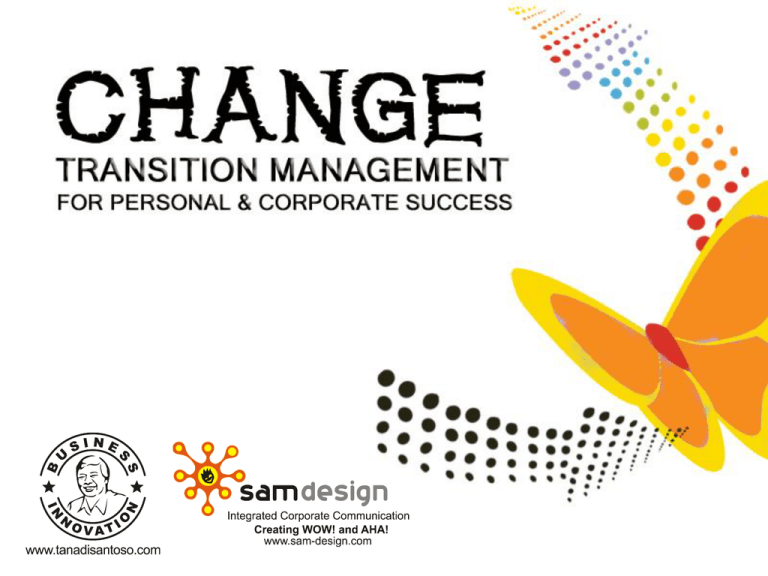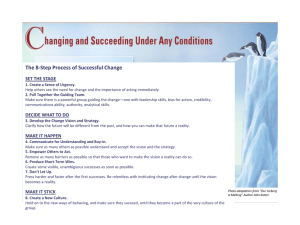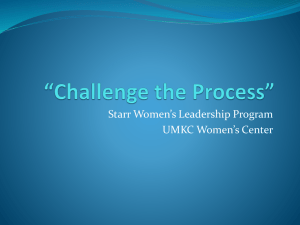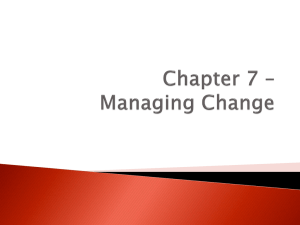TanadiSantoso_Change..
advertisement

Change management So what is Change Management? ‘It isn’t the changes that are so difficult , it’s the transitions. Change is not the same as transition. Change is situational: the new site, the new boss, the new team roles, the new policy. Transition is the psychological process people go through to come to terms with the new situation. change is external, transition is internal.’ Source: Managing Transitions, Making the most of change William Bridges You’ll never get me up on one of those butterfly things! Tiga elemen dalap perubahan perusahaan The push / pull model of Leadership Push Pull I am aware of myself LOGICAL ARGUMENT I make proposals I state reasons I state logical consequences ASSERTION I state my needs or wants I state my evaluations I persist I N T E G R I T Y C O N F I D E N C E thoughts, wants, feelings I am aware of you BUILDING BRIDGES I recap what you say I explore our views or feelings I self-disclose ATTRACTION I build on common ground I create a vision Change Management Vision Skills Incentives Resources Action Plan Change Skills Incentives Resources Action Plan Confusion Incentives Resources Action Plan Anxiety Resources Action Plan Vision Vision Skills Gradual Change Vision Skills Incentives Vision Skills Incentives Action Plan Resources Frustration Not Implemented Change Impact! First Individual Impact Organization Impact Change will start with individual, and will cause a rippling effect in an organization. The change cycle Source: Carnall (1986) Denial ‘If it ain’t broke why fix it?’ Internalisation ‘Actually this new system could be improved even further.’ Adapting ‘Now I understand the actions that I must take to improve performance.’ Defence ‘I’ve got too much to do’ Where are we today in the process of change ? ‘Why can’t I continue doing what I have always done?’ Discarding ‘If this is the new way of working then I don’t have to do X anymore.’ The core message ‘‘do things differently’’ How to communicate, PROCESSES manage and make decisions SYSTEMS How did we perform today ? PEOPLE / TRAINING Capacity to plan, achieve, analyse and find some opportunities CHANGE IN ATTITUDES AND BEHAVIOURS Sustainable results Continuous improvement The road to change VISION Goal target First key steps Milestones are we on target ? What is your VISION Of the Future? “if you do not know where you are going, any road gets you there” Sourcing-enabled change can be made to work if the conditions for change are positive… A framework for managing change… The conditions for change: Need for change + Ability to change + Willingness to change > Emotional / Personal cost + Financial cost Applied to outsourcing and sourcing: Need for Change Ability to Change Willingness to change • New product or service requires new sourced services • Ability to re-draw the organizational boundary • Operations leadership • Transition costs • Sourcing leadership • Increased focus on core competency • Access to a robust market for purchased services • Financial leadership • Increased management costs • Competitors are sourcing offshore • Internal team cannot make the change • Knowledge and skills to “manage” rather than “do” • Risk mgmt. leadership • Executive sponsorship • Customers • Suppliers Costs to Change • Reputation costs of an outsourcing project going wrong • Personal costs of individuals impacted • Increased politics Kotter’s 8 Stages of Change Management • • • • • • • • Increase Urgency Build the Guiding Team Get the Vision Right Communicate for Buy-In Empower Action Create Short Term Wins Don’t Let Up Make Changes Stick Stage 1: Increase Urgency Raise a feeling of urgency so folks say“let’s go”! What Works: • Show others the need for change [use valid information and data] • Never underestimate how much complacency, fear and anger may exist Stage 2: Build the Guiding Team Form a group that has the capability to guide the change process What Works: • Showing enthusiasm and commitment • Modeling trust and teamwork Team Functions • Task Orientation – Set clear and simple goals. • Roles - Assign a unique job to each team member. • Share Ideas – Brainstorm methods • Feedback – Share positive, frequent feedback on progress • High Expectations – Challenge team members to produce the best work possible Stage 3: Get The Vision Right Create the right vision and strategies to guide action What Works: • Trying to see -literally- possible futures • Vision so clear- it can be articulated in one minute or written on 1 page Stage 4: Communicate for Buy-In Communicate change vision and strategies to create understanding and buy-in What Works: • Keeping communication simple and heartfeltnot complex and technical • Know what your folks are “feeling” • Speak to anxieties, fear, confusion, anger Communicating the Change • Identify the what and why of the change. • Target specific results. • Don’t dump information on people. • Welcome questions and feedback. • Acknowledge the feelings associated with the change Communication Tips • Give constructive feedback. • Be tolerant of mistakes. • Praise in public, criticize in private. • Once you've delegated, never take it back (except in impending disaster!) Remember this… TELL ME I will forget SHOW ME I might remember INVOLVE ME I will never forget Stage 5: Empower Action Deal effectively with obstacles that block action. What Works: • Find folks with change experience who can state “we won and you can too” Stage 6: Create Short-Term Wins Produce short-term wins to energize the change helpers, enlighten pessimists, defuse cynics and build momentum What Works: • Early wins that come fast • Wins that are visible to as many people as possible • Wins that speak to powerful players whose support you need but do not yet have Stage 7: Don’t Let Up Continue with wave after wave of change, not stopping until the vision is a reality What Works: • Looking for ways to keep the urgency up • As always- show ‘em, show ‘em, show ‘em Stage 8: Make Change Stick Be sure the changes are embedded so that the new way of operating will stick What Works: • Not stopping at Step 7- it isn’t over until the changes have roots Plant your own garden, decorate your own soul, instead of waiting for someone to bring you flowers. Veronica A Shoffstall Tanadi Santoso Chief Catalyst Officer Sam-Design PT. Kompakindo Media Dewata Kombes M Duriyat 39 Surabaya - tel: 031-5459975 0818329971 Plaza Lippo 12th Floor Jend. Sudirman Kav.25 Jakarta - Tel 021-5212323 Email: ts@sam-design.com www.sam-design.com www.tanadisantoso.com







